Related Research Articles

Superconductivity is a set of physical properties observed in certain materials where electrical resistance vanishes and magnetic fields are expelled from the material. Any material exhibiting these properties is a superconductor. Unlike an ordinary metallic conductor, whose resistance decreases gradually as its temperature is lowered, even down to near absolute zero, a superconductor has a characteristic critical temperature below which the resistance drops abruptly to zero. An electric current through a loop of superconducting wire can persist indefinitely with no power source.
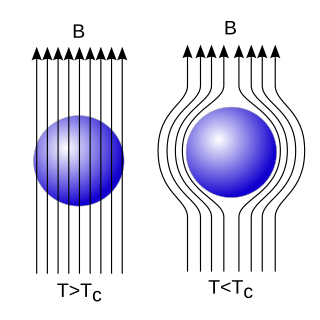
The Meissner effect is the expulsion of a magnetic field from a superconductor during its transition to the superconducting state when it is cooled below the critical temperature. This expulsion will repel a nearby magnet.

High-temperature superconductors are defined as materials with critical temperature above 77 K, the boiling point of liquid nitrogen. They are only "high-temperature" relative to previously known superconductors, which function at even colder temperatures, close to absolute zero. The "high temperatures" are still far below ambient, and therefore require cooling. The first break through of high-temperature superconductor was discovered in 1986 by IBM researchers Georg Bednorz and K. Alex Müller. Although the critical temperature is around 35.1 K, this new type of superconductor was readily modified by Ching-Wu Chu to make the first high-temperature superconductor with critical temperature 93 K. Bednorz and Müller were awarded the Nobel Prize in Physics in 1987 "for their important break-through in the discovery of superconductivity in ceramic materials". Most high-Tc materials are type-II superconductors.
Metallic hydrogen is a phase of hydrogen in which it behaves like an electrical conductor. This phase was predicted in 1935 on theoretical grounds by Eugene Wigner and Hillard Bell Huntington.
A room-temperature superconductor is a hypothetical material capable of displaying superconductivity at temperatures above 0 °C, which are commonly encountered in everyday settings. As of 2023, the material with the highest accepted superconducting temperature was highly pressurized lanthanum decahydride, whose transition temperature is approximately 250 K (−23 °C) at 200 GPa.

A fermionic condensate is a superfluid phase formed by fermionic particles at low temperatures. It is closely related to the Bose–Einstein condensate, a superfluid phase formed by bosonic atoms under similar conditions. The earliest recognized fermionic condensate described the state of electrons in a superconductor; the physics of other examples including recent work with fermionic atoms is analogous. The first atomic fermionic condensate was created by a team led by Deborah S. Jin using potassium-40 atoms at the University of Colorado Boulder in 2003.

Magnesium diboride is the inorganic compound with the formula MgB2. It is a dark gray, water-insoluble solid. The compound has attracted attention because it becomes superconducting at 39 K (−234 °C). In terms of its composition, MgB2 differs strikingly from most low-temperature superconductors, which feature mainly transition metals. Its superconducting mechanism is primarily described by BCS theory.
In a standard superconductor, described by a complex field fermionic condensate wave function, vortices carry quantized magnetic fields because the condensate wave function is invariant to increments of the phase by . There a winding of the phase by creates a vortex which carries one flux quantum. See quantum vortex.
Tom Timusk is a Professor Emeritus of Physics at McMaster University in Hamilton, Ontario Canada. He is a retired member of the Condensed Matter research team at McMaster. He was an immigrant from Estonia displaced by Second World War. He settled in Hamilton, Ontario Canada.
Type-1.5 superconductors are multicomponent superconductors characterized by two or more coherence lengths, at least one of which is shorter than the magnetic field penetration length , and at least one of which is longer. This is in contrast to single-component superconductors, where there is only one coherence length and the superconductor is necessarily either type 1 or type 2. When placed in magnetic field, type-1.5 superconductors should form quantum vortices: magnetic-flux-carrying excitations. They allow magnetic field to pass through superconductors due to a vortex-like circulation of superconducting particles. In type-1.5 superconductors these vortices have long-range attractive, short-range repulsive interaction. As a consequence a type-1.5 superconductor in a magnetic field can form a phase separation into domains with expelled magnetic field and clusters of quantum vortices which are bound together by attractive intervortex forces. The domains of the Meissner state retain the two-component superconductivity, while in the vortex clusters one of the superconducting components is suppressed. Thus such materials should allow coexistence of various properties of type-I and type-II superconductors.
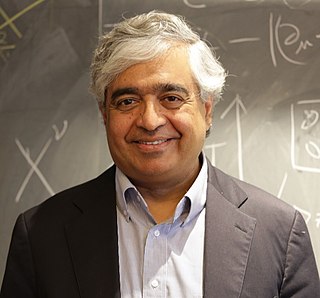
Subir Sachdev is Herchel Smith Professor of Physics at Harvard University specializing in condensed matter. He was elected to the U.S. National Academy of Sciences in 2014, received the Lars Onsager Prize from the American Physical Society and the Dirac Medal from the ICTP in 2018, and was elected Foreign Member of the Royal Society ForMemRS in 2023. He was a co-editor of the Annual Review of Condensed Matter Physics 2017–2019, and is Editor-in-Chief of Reports on Progress in Physics 2022-.

David R. Nelson is an American physicist, and Arthur K. Solomon Professor of Biophysics, at Harvard University.
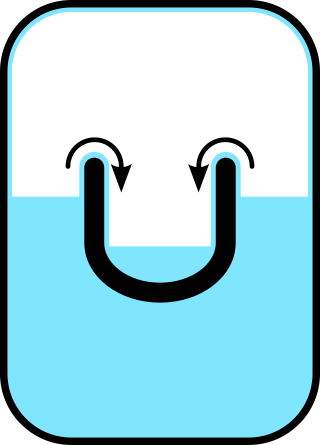
Superfluidity is the characteristic property of a fluid with zero viscosity which therefore flows without any loss of kinetic energy. When stirred, a superfluid forms vortices that continue to rotate indefinitely. Superfluidity occurs in two isotopes of helium when they are liquefied by cooling to cryogenic temperatures. It is also a property of various other exotic states of matter theorized to exist in astrophysics, high-energy physics, and theories of quantum gravity. The theory of superfluidity was developed by Soviet theoretical physicists Lev Landau and Isaak Khalatnikov.
Nikolai Borisovich Kopnin was a Russian physicist specializing in superconductivity.
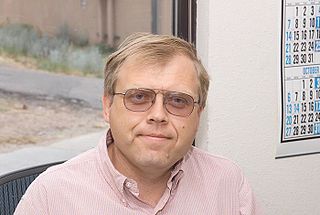
Alexander V. Balatsky is a USSR-born American physicist. He is the professor of theoretical physics at NORDITA and University of Connecticut. He served as the founding director of the Institute for Materials Science (IMS) at Los Alamos National Laboratory in 2014–2017.
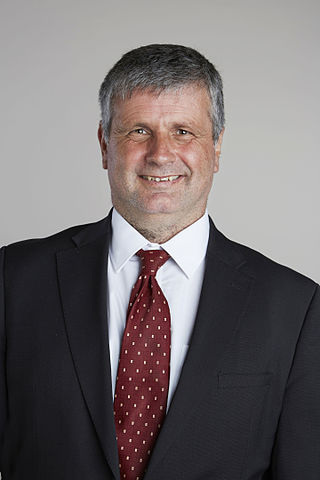
Andrew Peter Mackenzie is a director of Physics of Quantum Materials at the Max Planck Institute for Chemical Physics of Solids in Dresden, Germany and Professor of Condensed Matter Physics at the University of St Andrews, Scotland. He became a co-editor of the Annual Review of Condensed Matter Physics as of 2020.
Several hundred metals, compounds, alloys and ceramics possess the property of superconductivity at low temperatures. The SU(2) color quark matter adjoins the list of superconducting systems. Although it is a mathematical abstraction, its properties are believed to be closely related to the SU(3) color quark matter, which exists in nature when ordinary matter is compressed at supranuclear densities above ~ 0.5 1039 nucleon/cm3.

A hopfion is a topological soliton. It is a stable three-dimensional localised configuration of a three-component field with a knotted topological structure. They are the three-dimensional counterparts of 2D skyrmions, which exhibit similar topological properties in 2D. Hopfions are widely studied in many physical systems over the last half century, as summarized here http://hopfion.com
The condensate of electron quadruplets is a proposed state of matter in which Cooper pairs are formed but do not exhibit long-range order, but electron quadruplets do. One example of the proposed electron quadruplet condensates is charge-4e superconductivity. Another example is "quartic metal" phase is related to but distinct from those superconductors explained by the standard BCS theory; rather than expelling magnetic field lines as in the Meissner effect, it generates them, a spontaneous Nernst effect that indicates the breaking of time-reversal symmetry. After the theoretical possibility was raised, observations consistent with electron quadrupling were published using hole-doped Ba1-xKxFe2As2 in 2021.
GrigoryEfimovich Volovik is a Russian theoretical physicist, who specializes in condensed matter physics. He is known for the Volovik effect.
References
- ↑ "Egor Babaev". Archived from the original on 20 October 2021. Retrieved 19 October 2021.
- ↑ "egor babaev's home page". www.theophys.kth.se. Archived from the original on 12 May 2021. Retrieved 30 September 2018.
- ↑ "Superfluid States of Matter". CRC Press. 15 April 2015. Archived from the original on 1 March 2020. Retrieved 30 September 2018.
- ↑ Babaev, Egor; Speight, Martin (17 November 2005). "Semi-Meissner state and neither type-I nor type-II superconductivity in multicomponent superconductors". Physical Review B. 72 (18): 180502. arXiv: cond-mat/0411681 . Bibcode:2005PhRvB..72r0502B. doi:10.1103/PhysRevB.72.180502. S2CID 118146361.
- ↑ "Physicists unveil a theory for a new kind of superconductivity". Archived from the original on 30 September 2018. Retrieved 30 September 2018.
- ↑ Babaev, E.; Carlström, J.; Silaev, M.; Speight, J.M. (15 February 2017). "Type-1.5 superconductivity in multicomponent systems". Physica C: Superconductivity and Its Applications. 533: 20–35. arXiv: 1608.02211 . Bibcode:2017PhyC..533...20B. doi:10.1016/j.physc.2016.08.003. ISSN 0921-4534. S2CID 59580432.
- ↑ Babaev, Egor; Sudbø, Asle; Ashcroft, N. W. (7 October 2004). "A superconductor to superfluid phase transition in liquid metallic hydrogen". Nature. 431 (7009): 666–668. arXiv: cond-mat/0410408 . Bibcode:2004Natur.431..666B. doi:10.1038/nature02910. ISSN 0028-0836. PMID 15470422. S2CID 4414631.
- ↑ "Superfluid States of Matter". CRC Press. 15 April 2015. Archived from the original on 1 March 2020. Retrieved 30 September 2018.
- ↑ "Grants on the web". Archived from the original on 30 September 2018. Retrieved 30 September 2018.
- ↑ Babaev, Egor; Faddeev, Ludvig D.; Niemi, Antti J. (27 February 2002). "Hidden symmetry and knot solitons in a charged two-condensate Bose system". Physical Review B. 65 (10): 100512. arXiv: cond-mat/0106152 . Bibcode:2002PhRvB..65j0512B. doi:10.1103/PhysRevB.65.100512. S2CID 118910995.
- ↑ "New Type of Superconductivity Spotted". Science | AAAS. 13 March 2009. Archived from the original on 2 May 2024. Retrieved 30 September 2018.
- ↑ "Physicists unveil a theory for a new kind of superconductivity". Archived from the original on 30 September 2018. Retrieved 30 September 2018.
- ↑ hakan.johansson@svd.se, Håkan Johansson |. "Varning: Ny superdator kan röja alla hemligheter (SvD Premium) | SvD". SvD.se (in Swedish). Archived from the original on 30 September 2018. Retrieved 30 September 2018.
- ↑ "Superfluid States of Matter". CRC Press. 15 April 2015. Archived from the original on 1 March 2020. Retrieved 30 September 2018.
- ↑ Grinenko, Vadim; Weston, Daniel; Caglieris, Federico; Wuttke, Christoph; Hess, Christian; Gottschall, Tino; Maccari, Ilaria; Gorbunov, Denis; Zherlitsyn, Sergei; Wosnitza, Jochen; Rydh, Andreas; Kihou, Kunihiro; Lee, Chul-Ho; Sarkar, Rajib; Dengre, Shanu; Garaud, Julien; Charnukha, Aliaksei; Hühne, Ruben; Nielsch, Kornelius; Büchner, Bernd; Klauss, Hans-Henning; Babaev, Egor (18 October 2021). "State with spontaneously broken time-reversal symmetry above the superconducting phase transition". Nature Physics . 17 (11): 1254–1259. arXiv: 2103.17190 . Bibcode:2021arXiv210317190G. doi:10.1038/s41567-021-01350-9. ISSN 1745-2481. S2CID 235732434. Archived from the original on 21 July 2023. Retrieved 2 May 2024.
- ↑ "Press release of the Royal Swedish Academy of Science" (PDF). Archived (PDF) from the original on 30 September 2018. Retrieved 29 September 2018.
- ↑ "Video of the presentation". Archived from the original on 30 September 2018. Retrieved 29 September 2018.
- ↑ "News release of the Royal Swedish Academy of Science". Archived from the original on 16 January 2021. Retrieved 29 September 2018.